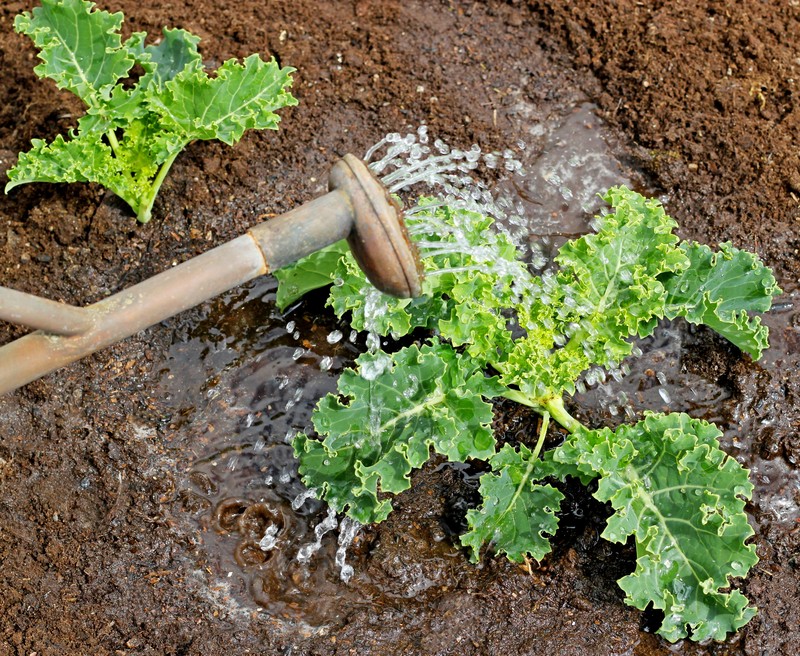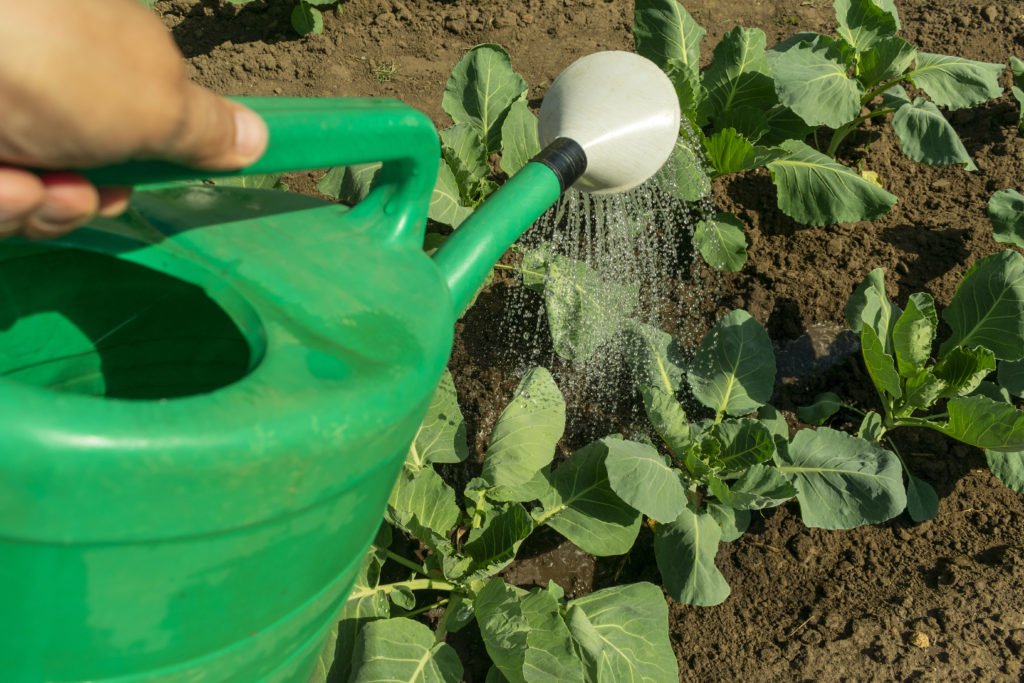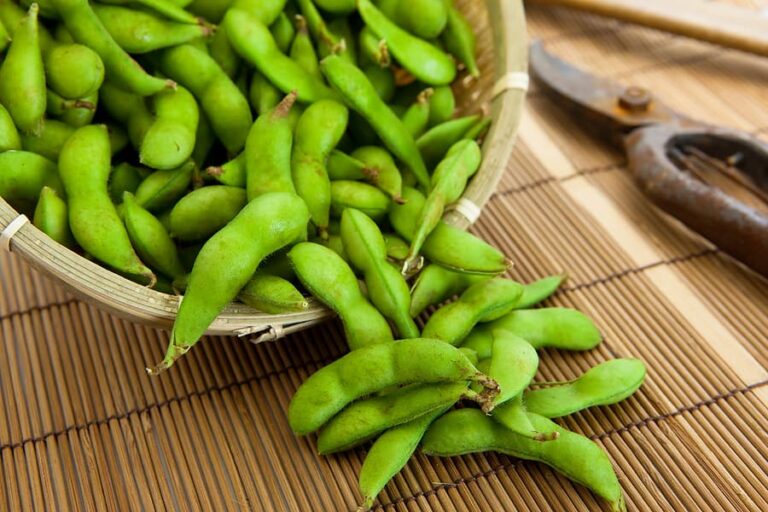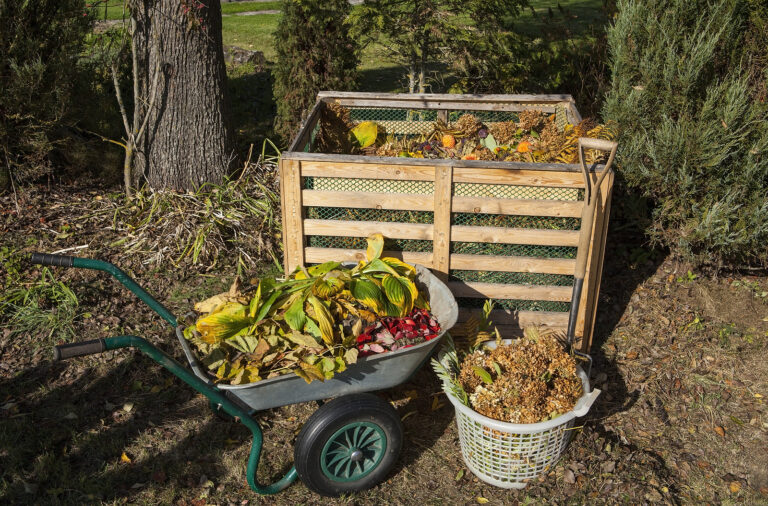Watering Vegetables: Critical Watering Times
Water is essential for vegetable growth. Vegetables are mostly water: an ear of corn is 70 percent water, a potato is 80 percent water, and a tomato is 95 percent water. Vegetables will not grow and yield without consistent, even watering.
Most vegetable crops require one inch or more of water each week during the growing season. This is the equivalent of about ¾ of a gallon of water. In hot, dry conditions vegetables may demand more water.
Good Products for Raised Bed Growing at Amazon:
- Galvanized Raised Bed 8×3
- Cedar Raised Bed 4×8
- Elevated Cedar Planter 4×2
- Walk-In Greenhouse Tunnel 15x7x7
- Row Cover for Freeze Protection 10×30
Insufficient or uneven water can cause plants to grow in fits and starts and may result in wilting, blossom drop, leaf drop, malformed fruits, and sometimes death of the plant.

When to water vegetables
To know when your garden needs water, feel the soil, and look at the plants.
- If the soil is moist and sticky, if it forms a ball in the palm of your hand when you make a fist, you do not need to water.
- If the soil does not hold together in your hand if crumbles and runs between your fingers, it is too dry, and it is time to water.
- When plants wilt and look droopy in the morning, it is time to water.
The best rule is to keep vegetables and fruits evenly moist: If you stick your finger in the soil and it comes away dry, it’s time to water. If it comes away glistening wet, wait a day or two before you water it again. If it comes away damp, not dry, and not glistening, the soil is evenly moist.

Crop-by-crop critical times to get the watering right
- Asparagus: during spear development and production and during fern development; less water is needed when ferns reach full size.
- Beans, dry: during pollination, flowering, and pod development; blossoms may drop and pods may fail to enlarge if watering is inadequate; ¾ gallons (2.8 liters) per week per foot of row.
- Beans, snap: during pollination, flowering, and pod development; blossoms may drop and pods may fail to enlarge if watering is inadequate; 1 gallon (3.7 liters) per week per foot of row.
- Beans, lima: during pollination, flowering, and pod development of pods; blossoms may drop and pods may fail to enlarge if watering is inadequate; 1 gallon (3.7 liters) per week per foot of row.
- Beets: consistent, even water throughout the growing season and especially during root development to avoid cracking and knobby roots and hot flavor–symptoms of water stress; 1 gallon (3.7 liters) per week per foot of row or square yard.
- Broccoli: consistent even moisture during the entire growing season, especially early to prevent buttoning and during head development; 1 gallon (3.7 liters) per week per foot of row. Quality will be reduced if plants go dry at any time.
- Brussels sprouts: consistent even moisture during the entire growing season, especially early to prevent buttoning and during head development; 1 gallon (3.7 liters) per week per foot of row.
- Cabbage: consistent even moisture during the entire growing season; 1½ gallons (5.6 liters) per plant per week or 12 inches (30cm) per season. Too much water during head development can cause heads to split; keep watering even.
- Cantaloupe: during flowering, fruit set, and fruit development; 1½ gallons (5.6 liters) per plant per week or 18 inches (45cm) per season.
- Carrots: consistent, even water throughout the growing season and especially during root development to avoid cracking and knobby roots and hot flavor–symptoms of water stress; ¾ gallon per week per foot of row or 18 inches (45cm) per season.
- Cauliflower: consistent even moisture during the entire growing season, especially early to prevent buttoning and during head development; 1 gallon (3.7 liters) per plant per week. Quality will be reduced if plants go dry at any time.
- Celery: consistent even moisture through the season; celery is shallow-rooted and needs frequent irrigation; 2 to 3 gallons (7.5-11 liters) per square yard a week, 9 inches (22cm) per season.
- Collards: consistent even moisture during the entire growing season; 1½ gallons (5.6 liters) per plant per week or 12 inches (30cm) per season. Quality is reduced if plants go dry at any time.
- Cool-season vegetables: keep cool-season crops evenly moist during warm weather or heat.
- Cole crops: consistent even moisture during the entire growing season and especially during head development, but not bursts of water which can cause head-splitting; 1½ gallon (5.6 liters) per plant per week or 12 inches (30cm) per season. Quality is reduced if plants go dry.
- Corn: corn requires consistent, even watering; water is critical during silking, tasseling, and ear development. Water when tassels on small cobs begin to shrivel and 10 days before cobs are picked. Water stress can cause tassels to shed pollen before silks on ears are ready for pollination; lack of pollination may result in a missing row of kernels and reduced yields.
- Cucumbers: even, consistent watering during bud development, flowering, fruit development; 1½ gallons (5.6 liters)per plant per week, or 25 inches (63cm) per season.
- Eggplants: even, consistent watering from flowering through harvest; 1½ gallons (5.6 liters) per plant per week or 18 inches (45cm) per season.
- Fruit trees: even water at flowering and again near harvest when fruit growth is most rapid.
- Fruiting vegetables: consistent, even watering is required during flowering and as fruits start to swell; this will increase the yield.
- Germinating seed: water frequently to keep the soil moist but be careful not to wash away the seed.
- Greens: consistent even moisture through the season; leaf crops are shallow-rooted and needs frequent irrigation; 1 gallon (3.7 liters) per foot of row or 2 to 3 gallons (7.5-11 liters) per square yard a week, 9 inches (22cm) per season; where regular watering is difficult to do a heavy watering of 4 gallons per sq yard every 10 days.
- Herbs: keep the soil just moist, not wet; herbs do best with less water; wait until they begin to wilt; 1½ gallons (5.6 liters) per plant per week at most.
- Kale: consistent even moisture during the entire growing season; 1½ gallons (5.6 liters) per plant per week or 12 inches (30cm) per season. Quality is reduced if plants go dry at any time.
- Kohlrabi: consistent, even water throughout the growing season and especially stem development to avoid cracking and knobby roots and hot flavor–symptoms of water stress; 1 gallon (5.6 liters)per week per foot of row or square yard.
- Leaf crops: consistent even moisture through the season; leaf crops are shallow-rooted and need frequent irrigation; 1 gallon (3.7 liters) per foot of row or 2 to 3 gallons (7.5-11 liters) per square yard a week, 9 inches (22cm) per season; where regular watering is difficult to do a heavy watering of 4 gallons (15 liters) per sq yard every 10 days.
- Lettuce: consistent even moisture through the season; lettuce is shallow-rooted and needs frequent irrigation; 1 gallon per foot of row or 2 to 3 gallons (7.5-11 liters) per square yard a week, 9 inches (22cm) per season; where regular watering is difficult to do a heavy watering of 4 gallons per sq yard every 10 days. Do not let loosehead or iceberg types go dry during head development.
- Melons: during flowering, fruit set, and fruit development; 1½ gallons (5.6 liters)per plant per week or 18 inches per season.
- Onion: onions have small root systems; watering is critical during bulb enlargement; 1 gallon (3.7 liters), per foot of row a week, or 15 inches (38cm) per season. Stop watering when tops fall over fall.
- Parsnip: consistent, even water throughout the growing season and especially during root development to avoid cracking and knobby roots and hot flavor–symptoms of water stress; 1 gallon (3.7 liters) per week per foot of row or square yard.
- Peas: during flowering, seed enlargement, and pod filling; 1 gallon (3.7 liters) per foot of row a week or 18 inches per season.
- Peppers: even, consistent watering from planting to fruit set and enlargement; 1 pint per plant a week when young, increasing to 1½ gallons (5.6 liters)per plant a week as the weather warms.
- Potatoes: even, consistent watering is best and especially during tuber set and enlargement; tubers will become knobby if they go dry during tuber development. Uneven watering at the end of the season can cause tubers to split.
- Radishes: consistent, even water throughout the growing season and especially during root development to avoid cracking and knobby roots and hot flavor–symptoms of water stress; ¾ gallon per week per foot of row or square yard.
- Root crops: consistent, even water throughout the growing season and especially during root development to avoid cracking and knobby roots and hot flavor–symptoms of water stress; 1 gallon (3.7 liters) per week per foot of row or square yard.
- Rutabaga: consistent, even water throughout the growing season and especially during root development to avoid cracking and knobby roots and hot flavor–symptoms of water stress; 1 gallon (3.7 liters) per week per foot of row or square yard.
- Seedlings: keep seedlings evenly moist, but avoid too wet soil which can cause damping-off; water to avoid wilting early in the plant’s life.
- Spinach: consistent even moisture through the season; spinach is shallow-rooted and needs frequent irrigation; 1 gallon per foot of row or 2 to 3 gallons (7.5-11 liters) per square yard a week, 9 inches per season; where regular watering is difficult to do a heavy watering of 4 gallons (15 liters) per sq yard every 10 days.
- Squash: even, consistent watering during bud development, flowering, and fruit development; 1½ gallons (5.6 liters)per plant per week, or 18 inches per season.
- Sweet corn: corn requires consistent, even watering; water is critical during silking, tasseling, and ear development. Water when tassels on small cobs shrivel and 10 days before cobs are picked. Water stress can cause tassels to shed pollen before silks on ears are ready for pollination; lack of pollination may result in a missing row of kernels and reduced yields.
- Strawberry: consistent, even watering during flowering and runner development.
- Swiss chard: consistent even moisture through the season; spinach is shallow-rooted and needs frequent irrigation; 1 gallon (3.7 liters) per foot of row or 2 to 3 gallons (7.5-11 liters) per square yard a week, 9 inches (22cm) per season; where regular watering is difficult to do a heavy watering of 4 gallons (15 liters) per sq yard every 10 days.
- Tomatoes: consistent, even watering is critical during flowering, fruit set, and fruit enlargement; 2½ gallons per plant each week or 24 inches (60cm) per season. More water may be needed for plants not mulched. Older late-maturing varieties may require less water near harvest.
- Transplants: keep transplants evenly moist; water to avoid wilting as roots develop and take hold; the first 5 days are critical.
- Turnip: consistent, even water throughout the growing season and especially during root development to avoid cracking and knobby roots and hot flavor–symptoms of water stress; ¾ gallon (2.8 liters) per week per foot of row or square yard.
- Vine crops: consistent, even watering is critical during flowering and fruiting.

Vegetable watering tips
• Keep an eye on your plants. Know the signs of water and heat stress: wilting foliage and sunburn. If plants are wilting at the end of a hot day there may be no concern. But if plants are wilting at the start of the day, water immediately. If plants show signs of sunburn (leaves with yellow or white spots in the center), place shade cloth over the plants.
• Know the soil in your garden. Examine the soil frequently to know how much water it is retaining. Vegetables grow best in soil that is evenly moist, meaning not too wet and not too dry. Thrust a finger into the soil; if come out dry, the soil needs water; if it comes out glistening wet, the soil is too wet; if it comes out just damp, the water is just right. Sandy soil requires more watering, clay soil less. Add well-aged compost to your garden to keep soil moisture just right.
• Water plants deeply. Irrigate so that the root zone receives water, not just the top few inches. You can push a long wooden dowel into the soil after watering to get a sense of how deeply you’ve watered. The probe will move easily through wet soil and haltingly or not at all through dry soil.
• Avoid runoff. Apply water until it begins to puddle then stop until the water is absorbed; then repeat the cycle so that the water penetrates the growing bed rather than runs off. A drip or low-volume irrigation system will aid in delivering water evenly. Furrows and basins can help stem runoff. Terraces on slopes will slow runoff.
• Adjust the watering schedule as necessary. Water more frequently in hot or droughty weather; water less frequently in cool or cloudy weather. Water in the morning or in the evening when evaporation is lower. Avoid watering in windy conditions.
• Most vegetables need an inch of water per week. That is about 62 gallons (234 liters) for every 100 square feet; this amount will soak down to about 8 inches in the soil. Use a rain gauge to be sure your crops are getting the water they need. If rain is insufficient, you must make up the difference through irrigation.
• The best way to water is to deliver water to the base of the plant: use drip irrigation or small trenches that will allow the water to flow and seep into the ground. Sprinkler and overhead irrigation can result in foliar disease, especially if plants do not thoroughly dry before evening or cool temperatures.
• Drip and trickle irrigation systems are the most efficient and can place water very near plant roots. These systems have drip heads that can measure the amount of water delivered to the garden. To measure overhead watering, place 4 or 5 small straight-sided containers around the garden while watering; when 1 inch collects in the containers you have delivered an inch of water to the garden.
• The amount of water needed will depend on the type of soil in the garden: clay soil will hold more water than sandy soil and require less watering. Soil rich in organic matter is best; it is moisture retentive and well-draining. Vegetables growing in containers require frequent monitoring and may require more frequent watering.
• Plants with healthy root systems will need water every 5 to 7 days on average unless the weather is hot or windy; temperature and wind can affect the soil’s water-holding capacity.
• Shallow-rooted vegetables require more frequent watering.
• Vegetables need more water when days are sunny and humidity is low.
• The best time to water is in the morning as plants begin to use water during the day. Watering in the heat of the day will result in a loss of water to evaporation. Watering in the evening can lead to foliar diseases if foliage does not dry before nightfall.
• Water when the air is still. Watering in windy weather will mean greater evaporation.
• Lightly cultivate around plants before watering–not deeply; this will allow the soil to accept and retain moisture.
• Long drip or trickle irrigation allows water to seep slowly and deeply into the soil and not runoff. Watering to a depth of 5 to 6 inches encourages the growth of deep roots. Avoid quick, shallow watering which encourages shallow root growth. Shallow roots are more susceptible to damage by the sun and heat.
• Water before plants become wilted and stressed. When plants wilt the damage may already be irreversible. Plants that are wilted in the morning need water immediately. Check the soil moisture every day or two to make sure the soil is moist, not dry or too wet.
• Do not over-water. Too much water can leach nutrients from the soil and drown plants; plant roots require oxygen from the soil to help plants grow.
• Mulch around plants to conserve soil moisture. Add aged compost and organic matter to the soil regularly. This will increase the soil’s moisture-holding capacity.
• Do not let weeds grow in the garden. Weeds compete with vegetables for water and nutrients.
• Grow crops in the right season. Cool-weather crops grown in early spring and fall require less water than if they are grown in warm weather.
• Harvest vegetables when they are young and just ripe. Young vegetables will require less water and will be tenderer and tastier than vegetables that sit in the garden past their peak.
Hot weather watering solutions
Vegetable crops can become stressed in hot weather if not sufficiently watered. Vegetables are not drought resistant.
Evenly moist soil can slightly lower the soil temperature and increase humidity around crops. This will help alleviate plant stress in hot weather.
• Group plants with similar water needs. Plant crops with similar watering needs close together. Group plants into “hydro zones”–groups of plants with similar water, soil, and exposure needs. This will allow for the most efficient application of water. Deep-rooted crops such as carrots and beets (roots to 5 or more feet) should be planted in one section of the garden. Plant medium-rooted crops such as tomatoes and corn (roots to 4 feet and sometimes less) in another.
• Water according to need. Shallow-rooted crops, new transplants, and seeds require more frequent watering than established crops with deeper roots. Soil moisture evaporates more quickly from the top two to four inches of soil than from deeper soil. Plants that are flowering or setting fruit need deep, even watering.
• Furrows and basins. Hand-water plants bordered by furrows or surrounded by basins. Seeds and transplants can be set at the bottom of 6 to 8-inch trenches, rather than on the top or sides of furrows in very hot summer regions. Basins 3 to 6 inches deep can be built around widely spaced crops such as squash, melons, and tomatoes. Use a hose-end bubbler attachment to irrigate.
• Soaker hoses. Use a soaker hose to water crops planted on flat beds. This is the most effective way to water leafy crops and crops intensively planted.
• Drip irrigation. Use a low-volume irrigation system with an emitter line for closely spaced plants. Use individual emitters for widely spaced plants. For vegetable gardens in sandy soil, set several 2-gph (gallons per hour) emitters about a foot apart in a row; in loam soil set several 1-gph emitters about 1½ feet apart in a row; in clay soil set several ½-gph emitters about 1½ feet apart in a row; in containers using potting soil set one or more ½- or 1-gph emitters in each container.
• Sunken beds. In arid regions, sunken beds–the opposite of raised beds–can be used to capture rain and irrigation water during the rainy season. During the dry season, crops planted in sunken beds will draw upon the reservoir soil moisture captured during the rainy season. Sunken beds will also protect plants from drying summer winds.
Also of interest:
Mulch: Hot Weather Garden Protection
Vegetable Garden Organic Pest Control
Garden Planning Books at Amazon:


